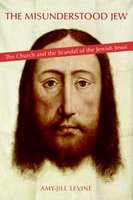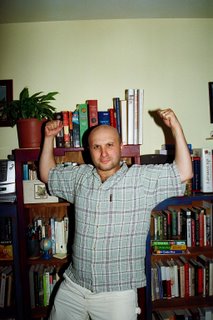What does The 99 Critical Shots in Pool have in common with Flotsam, a wordless children's picture book? What could possibly connect Patrick Hamilton, the long dead thriller writer who penned the play Gaslight, with the ultra-hip contemporary author Nick Hornby? Is there really a great book out there that talks about the Church of the Evolved Lamb?
The answers to all of these questions are in the first annual readers' favorites issue of Kash's Book Corner. I solicited titles from friends and colleagues, with the result being a remarkably eclectic list. I started with the intention of uncovering the great books of 2006, but soon discovered that no one, besides book critics, has any idea of what year a book was released. In the end, what does it even matter? Instead, we have a list of great books that were read in 2006.
Here's the list, in no particular order:
99 Critical Shots in Pool by Ray Martin and Rosser Reeves was the selection of one of my esteemed sales reps who has been playing pool with his wife this past year. "It's not for everyone, but if you know only one or two critical shots and want to learn a lot more, this is the book for you! There is no plot to confuse you, and there are no characters to remember. And when you finish, you can give yourself a name like 'The Viper,' or 'The Meatman,' or 'The Plague from the Hague.'"
Flotsam by David Wiesner was the pick by one of our children's room booksellers. "You fill in your own words in this fabulous picture book that blew my mind."
Hangover Square by Patrick Hamilton is just one of a great series of titles, according to one of my university press sales reps. "Europa Editions is really growing on me - they are something like the wonderful New York Review of Books series of found classics, and my favorite of the few I read this year was Hangover Square, a World War II era thriller."
It turns out that Nick Hornby recommends books as well as he writes them. His collected book journal, Housekeeping Vs. Dirt was the favorite of one of our booksellers, who said, "I read five other books because of what he wrote, including all of the Marjane Satrapi books."
Where can you go to worship the evolved lamb? Well you will have to read Android's Dream by John Scalzi. It's one of four science fiction books that made the list of the most voracious reader that I know. Despite many books to choose from, he managed to narrow his list down to four books. That's like the rest of us trying to name a favorite chapter of the year. He reads that much. Here are the rest of his Sci Fi titles: Mistborn by Brandon Sanderson, Rollback by Robert Sawyer (one of the few science fiction authors that I personally enjoy) and Widdershins by Charles de Lint.
The only other person to pick a science fiction title was a long-time colleague at the store. She reads all of the books that the rest of us pretend we don't enjoy, like romances and horror novels. Her pick, The Name of the Wind by Patrick Rothfuss, doesn't come out until the Spring of 2007. "It's an absorbing epic with realistic storytelling about an orphan with an aptitude for magic who goes to a university to become an alchemist." When I asked her where it took place, she looked at me as though I were an alien and said, "not in our world."
My assistant, an Indian-born Tibetan with a love for movies, gave his highest possible praise to Jimmy Santiago Baca's memoir A Place to Stand. "It's like a Bollywood movie, but it's real. He grows up with the gangs and he goes to prison. It's incredible. Just like Bollywood."
Abundance by Sena Jeter Naslund was the favorite of one of our marketers. "I went to Versailles and I didn't like it because they herded you through the rooms like cattle. Through this book I saw the rooms in a different light. Also, I really liked the writing."
The Children's Hospital by Chris Adrian garnered a rave review from our staff manager. "It's an epic story that's a total redux of the Biblical flood. He brings in theology, his personal experience and his research. It's incredible."
The Mayflower by Nathaniel Philbrick was "well written and well researched," according to the store's history expert. "He didn't have preconceived notions about what the story would be, and he isn't always politically correct. The first generation got along but the second generation forgot all of the lessons and that led directly to King Phillip's War. There are so many parallels to George W. Bush. They thought God was on their side and that they didn't need diplomacy."
Despite being out of print, Grey is the Color of Hope by Irina Ratushinskaya got a hearty endorsement from an old friend. "Ratushinskaya was a Russian political prisoner sent to Siberia. Grey was the color of the uniforms and pretty much the color of Siberia. She was a poet in her native language, so the writing is also good with a lot of symbolism. It's just a great story about human spirit and resilience."
My Penguin rep profferred two Penguin titles, Sweetness in the Belly by Camilla Gibb and The Rug Merchant by Meg Mullins. I don't blame him for cheering on his home team since Penguin puts out a lot of tremendous titles. And what else can he read when he has so many books on his list every few months? Here's what he has to say about these two novels:
"Sweetness in the Belly is a loving and affecting look at Islam from the point of view of an English orphan raised by a Sufi prophet, come of age in Ethiopia at the time of the revolution there, and living as an adult in an immigrant enclave of London. The astoundingly genuine voice makes it difficult to remember that it's fiction. And, it is a viewpoint on Islam that is lacking in most of what we see and hear; that is, that there is solace and peace to be found there, if one knows how to look."
"The Rug Merchant is the story of two very unlikely lovers, an Iranian immigrant rug merchant in New York and a college girl from a conventional and reasonably well-off American family. At once sad and sweet, it is a gentle and touching story of a love that can never truly be. The poignancy of the ending is superb."
My friend, the author Louise Ross, went a step further than my Penguin rep by self-promoting her novel Baking at Midnight. She wrote, "For local readers who enjoy chic lit, Baking at Midnight is great fun, a light read, and it has been a Boulder Bookstore bestseller!" Louise's book was easily the store's most successful self-published book of 2006. That's saying a lot since we get dozens of self-published titles every month.
Other titles that were mentioned:
Fiction
Prep by Curtis Sittenfeld.
Death and the Penguin by Andrey Kurkov.
One Good Turn by Kate Atkinson.
Wolf Brother (Chronicles of Ancient Darkness) by Michelle Paver and Geoff Taylor.
Fallen by David Maine.
Kill Me by Stephen White.
Fever and Spear (Your Face Tomorrow trilogy) by Javier Marias.
Dance and Dream (Your Face Tomorrow trilogy) by Javier Marias.
Explorers of the New Century by Magnus Mills.
Suite Francaise by Irene Nemerovsky.
Water for Elephants by Sara Gruen.
River Secrets by Shannon Hale.
Sacred Games by Vikram Chandra. (928 pages, by the way).
Anomaly by Anne Fleming.
Nonfiction
American Prometheus: The Triumph and Tragedy of J. Robert Oppenheimer by Kai Bird and Martin Sherwin.
Consider the Lobster by David Foster Wallace.
The Glass Castle by Jeanette Walls.
Getting Stoned with Savages by J. Maarten Troost.
Postwar by Tony Judt.
Boswell bestsellers for the week ending April 20, 2024
-
Boswell bestsellers for the week ending April 20, 2024
Hardcover Fiction:
1. *The Unsettled*, by Ayana Mathis (a few real signed copies, not tip-ins)
2. *I...
4 days ago










